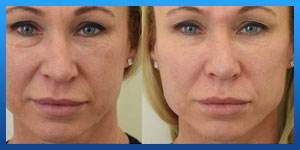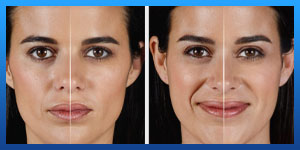Dermal Filler

What are Dermal Fillers?
Dermal fillers also known as fillers, injectable fillers and soft tissue fillers are a type of minimally invasive aesthetic medicine used to add volume, alter the contours of the face, and fill in wrinkles. Common areas to inject fillers are in the face, neck, and hands, resulting in a fuller, smoother and more youthful appearance. Dermal fillers are among the most popular aesthetic procedures because they carry immediate results, very few risks and little recovery time.
Before Dermal Fillers Procedure
When to consider Dermal Fillers
. If you have deep lines or facial wrinkles around the eyes, brow or mouth
. If you would like to change the contours of your jaw or lips
. If you are interested in a minimally invasive procedure
Advantages and Disadvantages
Pros:
. Filler injections are quick and only require a topical anesthetic at most
. Results are immediate and there is little to no downtime
. Fillers provide a subtle look that can be adjusted to meet your aesthetic needs
Cons:
. Cosmetic fillers are temporary and require repeat injections to maintain your goal
. Some people may be sensitive and experience bruising and swelling
. Results are dependent on the experience and qualifications of your injector
These are the top three pros and cons to weigh when considering fillers. If you want to focus on those specifically unique to you, please consult with your aesthetic plastic surgeon.

Are you a good candidate for dermal fillers?
The following are some common reason why you may want to consider dermal fillers:
. You have lines or wrinkles around your mouth, eyes or forehead.
. You’d like to enhance the volume in areas such as the cheeks, jaw line or lips.
. If you have scars and depressions in the skin resulting from acne, injury or congenital imperfections.
Preparing for Your Procedure
How do I prepare for a fillers procedure?
Your surgeon will provide thorough pre-treatment instructions and answer any questions you may have.
In the weeks before your injections, you’ll be asked to refrain from taking aspirin, ibuprofen, vitamin E, and any other medications that could cause bruising. Be sure to inform your physician of any medicines you are taking.
If you have a history of cold sores, your surgeon may recommend taking Valtrex as a precaution.
Your doctor may ask you to stop smoking before the procedure.
Regardless of the type of procedure to be performed, hydration is very important before and after treatment for safe recovery.

Dermal Filler
Risks and Side effects
As with any cosmetic procedure, patients must be in contact with their doctor during their recovery period. You should get in touch with your surgeon at the first sign of an abnormality or unexpected side effect. Prolonged pain and swelling could be a sign of infection or an allergic reaction.
There are very few risks associated with dermal fillers, but you should contact your doctor if:
. Swelling, bruising, or redness does not dissipate after one week
. You experience acute pain near the injection site coupled with asymmetry, lasting more than seven to ten days after the procedure.
. You develop any nodules or bumps in or around injected areas or any uneven areas around the skin.
You can help minimize certain risks by following the advice and instructions of your board-certified plastic surgeon, both before and after your filler injection procedure.
During Dermal Fillers Procedure
How is a dermal fillers procedure performed?
Dermal fillers are administered with a syringe to various areas on the face and head, including around the eyes, along the jaw, around the lips and in the forehead. The number, location and depth of the injections depend largely on the type of dermal fillers used and the desired results.
Some fillers contain a local anesthetic like lidocaine to enhance comfort during injection. Numbing cream may also be used.
What are my options?
There are three types of dermal fillers commonly used: temporary, semi-permanent, and permanent. Hyaluronic acid-based fillers are temporary, while other types of fillers offer longer-lasting results.
. Temporary Fillers
. Collagen-Based Fillers: Collagen is a naturally occurring protein that adds strength and structure to the skin. Collagen was the first filler on the market, but the arrival of hyaluronic acid-based fillers has decreased its popularity.
. Hyaluronic Acid-Based Fillers Like collagen, hyaluronic acid is a naturally occurring substance and primarily used to promote fullness and volume.
. Calcium Hydroxylapatite: Heavier and denser than hyaluronic acid, this filler is injected deeper, underneath the skin, and does not usually cause immune or allergic responses because the material is usually found in bones.
. Semi-Permanent Fillers
Longer-lasting dermal fillers typically contain thicker substances, such as the biodegradable synthetic filler known as poly-L-lactic acid. These types of soft tissue fillers are used to treat deeper facial lines, and though they offer semi-permanent results, it’s possible that you’ll need an occasional “touch up” several weeks after your initial injections.
. Permanent Fillers
Permanent fillers are made of polymethylmethacrylate (PMMA), which are microspheres that are not absorbed by the body. The filler also contains collagen and is only recommended for thick-skin areas such as the nasolabial folds. It is not recommended for any areas around the eyes or for the lips.
. Silicone Injections – Patient Safety Warning
Silicone injections are an unsafe and unacceptable option to use as a filler. These injections are not FDA approved and often offered by unlicensed individuals and should be avoided. Always consult with a board-certified plastic surgeon, , if you have questions about a particular type or brand.

What are the brand names for dermal fillers?
There are a number of soft tissue filler brand names, but some of the most common are:
. Hyaluronic Acid-Based Fillers: Restylane®, Restylane® Lyft, Restylane® Silk, Juvederm, Juvederm Volbella, Juvederm Voluma, PREVELLE Silk, Hydrelle, Belotero
. Collagen-Based Fillers: Cosmoplast, Cosmoderm, Evolence
. Semi-Permanent Fillers: Sculptra, Radiesse
. Permanent Fillers: Bellafill
After Dermal Fillers Procedure
Aftercare and Recovery
Immediately after injection
You will likely see the results of your injections immediately following the procedure, though it’s not uncommon for patients to experience swelling or minimal bruising in the area of the injection site. Your physician may give you an ice pack or cold compress to help stem swelling. The period of swelling will depend largely on the type of soft tissue filler you received, though most swelling, bruising, and redness should dissipate within one week to ten days.

Recovery time frame
One of the most enticing features of soft tissue fillers is their minimal recovery time. In the approximate week it takes for swelling and bruising to disappear, your doctor may advise you to avoid wearing hats or other headgear and only use small amounts of makeup.
How Long Will the Results Last?
The length of results from your dermal fillers is dependent on the type of injection you received:
. Collagen-Based Fillers: Results will last from two to four months.
. Hyaluronic Acid-Based Fillers: Results vary, though results of most common brands will last six to twelve months.
. Semi-Permanent Fillers: Results will last between twelve and eighteen months.
. Permanent Fillers: Results are typically still visible after five or more years.

